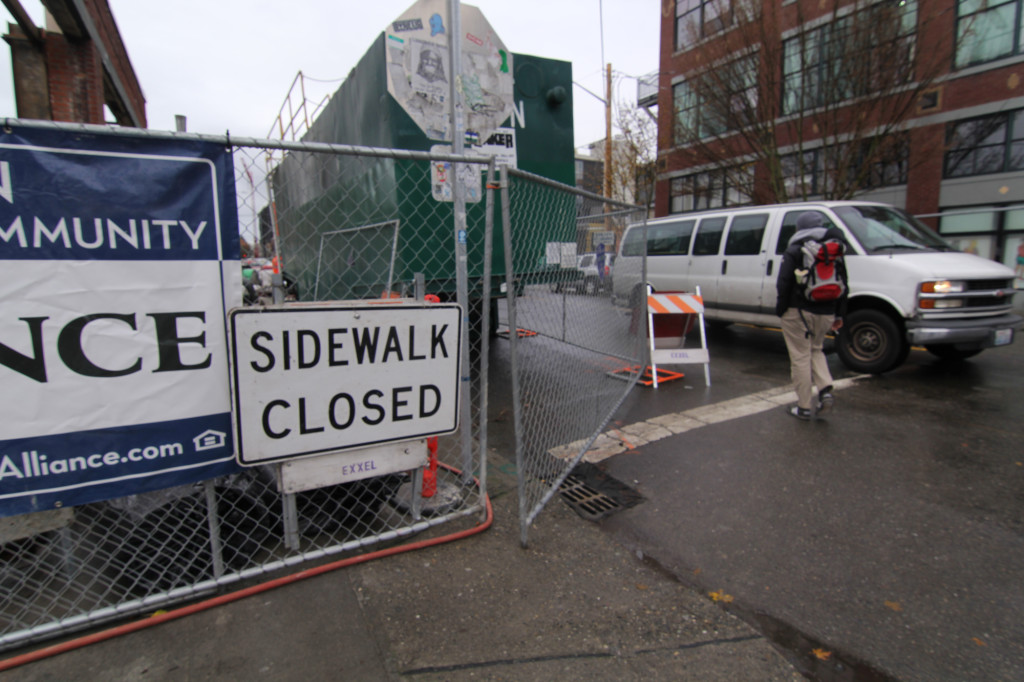Competition has broken out across the nation for city walkability, and this year it seems Seattle has been left in the dust. In addition, soon-to-be cuts to metro routes will possibly make transportation around Seattle more difficult for students and community members.
Walk Score released their rankings of America’s most walkable cities and Seattle has been placed at eight, down two places from last year.
Other larger cities such as Miami and Washington D.C. have been rated higher. Although the score for the city has gone down, individual neighborhoods have gained points, such as downtown, the Denny Triangle and Pioneer Square.

A student walks down 10th Avenue towards Pike Street between a closed sidewalk and a car. The increased amount of construction has created several obstacles for people traveling by foot, as well as by Metro.
Walkability is an important aspect of commuting in Seattle, but another life line for travelers is public transportation. On Walk Score, Seattle has a public transportation score of 59, which ranks the city as seventh on the national list. These scores won’t stand for long, however, because King County has proposed cutting 74 bus routes.
Seattle University senior and Campus Assistant Center (CAC) Student Manager Nickolas Elam explains that the transition to the altered routes may be difficult for students on campus who often use bus passes from the CAC.
“We see a lot of people using the bus for internships and work, so students are going to have to figure out a new way to get there pretty quickly when those bus lines are cut,” he said.
KOMO News reported that King County Metro Transit announced a $75 million budget shortfall. This cutback will mean that 74 bus routes will stop running, 107 routes reduced, and in total about 50,000 daily trips will disappear by next year.
Changed routes include 2, 3, 12 and many others, several of which are routes used often by Seattle U students and faculty. Junior Haley Jo Lewis hopes she will be able to adapt to the bus changes, especially since she uses her iPhone app to map her bus route. But some of the Hill’s favorite routes that will end include the 2, 4, 19, 21 and 7 express. When Lewis heard about the four being cut entirely, she was disappointed.
“I usually take the 2 or 4 downtown or the 49 to see friends at [the University of Washington],” she said. The loss of some of these lines will definitely have an impact, Lewis said.
“That would just mean that people would have to wait a lot longer for the next 2 line to come around and that’s going to affect a lot of people,” she said. “Most students at Seattle U are aware of the 2 and the 4 to go downtown.”
Awareness of the bus cuts has yet to reach much of campus, but students appear to be ready to adapt and the CAC hopes to help provide this information.
“The 4 I can easily spout off to a student to go downtown,” Elam said. “We are going to have to prepare our staff at the CAC and make sure they’re also aware and we can get people to and from places like downtown and UW.”
Lawmakers are saying the only way to end the route cuts would be an increase in King County motor vehicle excise tax.
According to King 5, these cuts are going to affect more that 80 percent of Metro’s bus and DART routes. Negative side effects to this include longer waits, more transfers and more crowded buses. Another possible outcome is an increase in traffic—Seattle has already been ranked the sixth worse U.S. city for traffic, which is a 16 percent increase from last year.
Traffic data company INRIX explains this rise in traffic is consistent with the blooming job market on the east side of the city. Traffic in the city is heaviest in areas between I-405 and Renton, Renton and Bellevue, and Bellevue and Lynwood. A typical 13-mile drive on I-5 South into Seattle takes an average of 30 minutes.
Despite the bad reputation for walking and traffic, Seattle always has the option of biking. The city was recently ranked number 10 for Bicycle’s Top Bike-Friendly Cities in 2012 and this year the city has jumped up to number four. Projects that have boosted the scores include the two-way track cycle on Broadway and the green bike lanes and boxes throughout the city.
The bike scene has taken off in Seattle and city officials are trying to support the movement. This spring the city was awarded a $1 million federal grant from Puget Sound Regional Council. This money is combined with a $750,000 grant from the Washington State Department of Transportation.
The City of Seattle statement for the grant states that the money will be used for bike and helmet stations in South Lake Union and downtown as part of Phase I in growing downtown neighborhoods.
One of the goals for this project is a bike share system in the city that will “make it easier for employees, residents and visitors to rely on public transportation,” said a statement.
There seems to be a potential problem with this plan if the reliance on public transportation fails due to the upcoming bus route cuts.








